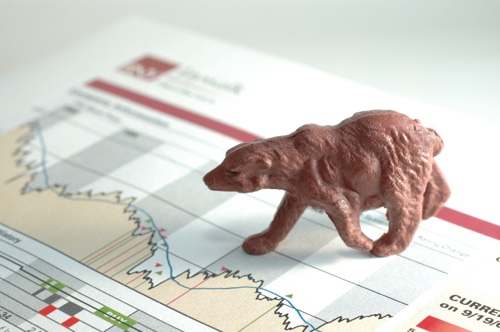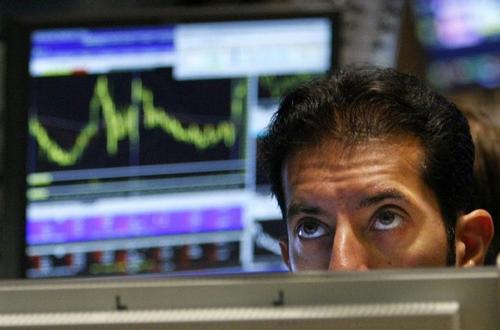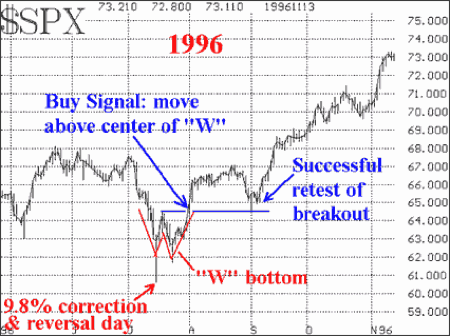Are we there yet? The many indications and signs of a stock market bottom.
When market indicators signal a strong market downtrend, we wonder about the obvious questions: when does the stock market finally hit bottom? And how can we tell if it has?
Make Unpopular Moves
If you’re brave enough to be a contrarian — which I think would serve us well to be — then the best time to invest would be when things hurt the most. In fact, you should begin to start feeling like a kid in a candy store, with the stock market presenting with juicy stocks available at firesale prices. When things suck so bad that you feel you’re backed into a corner, it may be time to deploy your remaining discretionary income into your battered 401k accounts.
If you don’t have an investment account just yet, you can open one at an online brokerage that allows for cheap or free transactions (up to a limit).
How To Tell When The Stock Market Has Hit Bottom
Now how about a quick review of what the bottom feels like? Not that we can accurately call it out, as short-term market timing doesn’t work on a consistent basis (in my humble opinion), but knowing the general vicinity of a bottom should serve us contrarians well.
Following are some typical symptoms and signs of a stock market bottom. When you get that far down, the only way to go (as they say) should be “up”!

1. People are worriedly asking what they should be doing next. Friends and family have been calling me asking me whether they should sell and abandon ship. And we’re not talking about lightening up their portfolios here and there. We’re talking about investors wondering if they should toss in the towel and move everything — all their funds, retirement and otherwise — over to safer vehicles.
The irony is that many of them are young, in stable jobs, and have no dependents. The greater irony is that many of them work in the financial sector. I can see why: if you work in the financial industry, you’re closer to the action and may feel more unnerved about what you’re seeing in “ground zero”, or you may feel much more vulnerable than the rest of us.
2. Stocks sell at vastly discounted prices but where are the buyers? Sure nobody wants to catch a falling knife, but when prices have stabilized and plateaued, it may be a sign that you can start dipping your toes in the stock market brew. The brave (or those who take risks) are eventually rewarded. If you’re ready to invest, here’s a list of awarded discount brokers that offer investment services at cheap rates.
3. People are using any excuse to sell. When it comes to our money, we’ve become trigger-happy. One false move and everyone wants to rush out the exits. The financial bailout failed….Sell! The bailout passed….Sell! Obama won….Sell! Jamie Lynn Spears is pregnant again….Sell!
4. You can’t bear to look at your portfolio. Because it hurts too much. I fall in this category, I must admit. I have yet to take stock of what losses we’ve experienced this year — and though I have some idea about what my portfolio now looks like, I want to keep myself in the dark. You may say that it’s foolish NOT to know how your investments are doing, but at the same time, I trust that my asset allocation is right for me and I’d rather protect my investments from myself. This is my way of preventing myself from doing anything rash or emotional; plus it’s all for the long term — so do I really need to get to the bottom of the ugly truth? Okay…. I’ll do so soon enough!
5. The media dishes out fresh painful anecdotes on the economy and/or the investment markets on a frightfully regular basis. The newspapers have been having a field day, giving us daily doses of doom and disaster from all fronts. Being somewhat of a rubbernecking curiosity seeker who loves to root out drama and has a natural interest in things morbid, I continue to read the daily news and absorb the media hype. Just keep me away from my own portfolio numbers.

6. When bad news is no longer a “big deal”. When things go bad for an extended period of time, a lovely thing happens and we stop being trigger-happy — people eventually get bored with the bad. They start to get jaded, and before long, even moderately bad news begins to sound “good”. It is at this point that markets decide they’re going to take a breather and stop falling, and may even rise on account of the next neutral economic story that hits the media channels.
7. It feels harder and harder to dollar cost average downwards. As time goes on, you may start to think that your contrarian strategies are beginning to fail you. Your stash of savings is depleting as you continuously shift more of it into long-term, riskier assets such as equities and REITs. But if you’ve got cash flow, you’ll hopefully continue to keep the faith. Based on my past experience with DCA and VCA (value cost averaging), I’ve seen these strategies become justified time and time again, once the markets recover.
8. When bullish market gurus admit that they were wrong. I follow an investment newsletter or two, and I’ve noticed a change. Some of the long term bullish “experts” are now crying “uncle”. Now, they’re not necessarily changing their stance on things… just admitting that they may have been wrong, to some degree, about their recent market calls (or lack thereof). It looks like this crazy October was unprecedented and caught them by surprise!
On the other hand, when you’ve got well-known perma-bears turning bullish, that’s a great sign that things may be about to turn.
When leading perma-bears turn bullish, you know you’re nearing a bottom. And that happened a few weeks ago when Jeremy Grantham said, “You are looking at the best prices in 20 years, and you should be making 7% to 8% to 9% real (inflation-adjusted) returns. The last time I was this optimistic was in the summer of 1982.”
9. When you hear people griping that they’re now going to have to work through retirement. Thanks to the previous amazing bull runs of the previous decades, we’ve been all trained to take and accept the extra risks afforded to us by the stock market. But if there’s one thing I’ve really learned this time around, it’s to make sure that I cut the risks in my portfolio by readjusting my asset allocation over time. The closer you are to retirement, the smaller your exposure should be to the stock market.
10. Annuities and boring savings accounts are in. Not long ago, noone wanted the turtle-paced, slow-mo returns of fixed annuities, ordinary bank accounts and plodding CDs yielding 5% a year. These days, those returns are quite appealing and look awfully sweet. But with everyone thinking the same thing, it could be time to reroute those long term safe funds over into more exciting investments… if you dare 😉 .
 Photo by Daylife.com
Photo by Daylife.com
Other Signs of A Stock Market Bottom Around The Web
If you search the web, you’ll get more serious discussion of what makes for a stock market bottom. So I decided to compile a few of them here.
From Forbes, here’s a technical view:

A typical market bottom consists of a “W” formation, not a “V,” but there is no reason to be stubborn. Rather, we will let the market tell us where the bottom is.
In a typical scenario, a declining market does not make a “V” bottom, but rather rallies and then returns to the vicinity of that same bottom (i.e., retests the bottom) before eventually moving higher. Thus, on the S&P 500 Index (SPX) chart (or other major index), a “W” formation takes shape.
From Motley Fool:
Yet among all this doom and gloom, I saw signs of hope. I don’t know if Friday, Oct. 10th will be heralded by historians as the bottom of this bear market, a day on which the Dow hit an intra-day low below 8,000, but I think it might be close.
But some of the classic signs of the bottom of the bear market were there:
1. Capitulation.
2. High volume, indiscriminate panic selling, regardless of valuation.
3. No obvious catalyst for a bounce.
4. Mass pessimism.
5. To date, it’s the worst calendar year fall in U.S. stocks since 1931.
6. The most recent bubble, commodities, has now also burst.
From Seeking Alpha, some indicators to watch out for:
1. The CBOE Volatility Index (“the VIX”) continues to set record highs. The VIX is a measure of the premium value placed on S&P 500 option contracts. It’s basically the cost of portfolio insurance. When fear is high, so are insurance costs.
2. Weak hands walk away and the herd sells.
3. Closed-end funds can be an indicator — see how many are no longer fetching a premium. The fewer the funds that command a premium, the closer you may be to a bottom.
4. Deep discounts in funds abound.
Copyright © 2008 The Digerati Life. All Rights Reserved.

{ 27 comments… read them below or add one }
regardless of what he has said, Obama has yet to deal with the structrual concerns of our economy, nor has Paulson or Bernake, we all just a Pay check away from a pink slip
As always an excellent post.
However, I find the discussion of market bottoms to be not useful. The real answer is that nobody knows… there are many “signs” so many that you have to wonder whether they all mean anything…
The real answer in my view is to take the long term view that things will be as they have always been. The rules of economics haven’t changed, nor are they any more likely to change than human nature. It’s all about understanding that in the long run things tend to regress to the mean. The stock market yields about 8% a year in the long run – really bad down years follow really good up years and vice versa. In the end, all that matters is the average (and peace of mind).
I agree Shadox, that nobody can really pinpoint the bottom and all we can do is to check out past history and make relative comparisons.
All we know is that today’s prices are “cheaper” than they were a few years ago (based on PE ratios and not absolute share prices), and maybe a better time to buy in recent years, but nobody really knows where bottom is.
But when vocal perma-bears (stock market experts who’ve been typically ultra-bearish) change their outlook, that should count for something.
I agree that the bottom can’t be predicted, but since we have fallen off the top so much, it is time to enter the market in lots.
Another interesting way of looking at how close we must be to the bottom is to take a look at the 5 year P/E lows and compare them to where we stand today.
Here is a list that does that for Dow stocks:
P/E of Dow JOnes stocks
Since your 10 signs are already happening, I believe that we are pretty close to the bottom!
I would also add the following signs:
– When companies are being traded below their book value.
– When companies showing good and steady growth along with good liquidity ratios are getting hurt as well.
– When people start thinking about the great depression.
– When people say “but this time, it’s different”
I think it’s probably the time of our life to start investing! I’m sure that we will be laughing in 3 years!
Today’s bottom could be tomorrow’s top.
I think putting money in the market right now in small chunks makes sense. The only problem is I dont really have a clear sense of the stock market. I have looked at a few stocks like Wells Fargo but I was surprised that they have not fallen as much as I would have thought. I guess people think that once the dust settles they will be one of the last men standing. I guess I should just go with mutual funds and forget about stock picking.
I really wish I could say that I think we are at a bottom, but I think we slowly trickle down or grind sideways a few years until this credit crisis ends.
I don’t see any regulatory changes that would change anything. There has been a lot of talk about the regulations that were instituted after the Great Depression and how they would have avoided a lot of the nonsense that has gone on. Easing of the regulations was promoted for greater profits of some and has resulted in greater losses for others.
nothing like taking a shot at the spears family. Well done!
I don’t know if we are at a bottom but I do believe there are stocks priced at levels where I believe the expected returns are worth the risk so I am buying. But I am not so sure we are at the bottom that I am investing all my money now in stocks.
So…. are we at a bottom… now? 🙂
Guys, I need your help! I have been reading that no one can time. If this were true, then how come the blog that I discuss below has been timing the tops and bottoms of the market before they happen or as they happen practically without fail. If you think that this is not true, I have been following the blog but you can check it yourself by looking at pages cached by google. (Google bots do not lie, and the cache material with a time-stamp). Therefore, the information on the blog is honest and accurate.
Here is a sample of predictions:
1. Bottom of October 10:
http://financialtraders.blogspot.com/2008/10/stock-market-crash-october-2008-bottom.html
2. Bottom of October 16:
http://financialtraders.blogspot.com/2008/10/dow-sp500-nasdaq-100-bottom-october.html
3. Top of November 4(election day top),
http://financialtraders.blogspot.com/2008/11/stock-price-prediction-tomorrows-stock.html
4. Bottom of November 13,
http://financialtraders.blogspot.com/2008/11/stock-market-bottom-november-2008-price.html
5. Bottom of November 14 (today):
http://financialtraders.blogspot.com/2008/11/tomorrows-stock-price-prediction-qqqq.html
How can these people do this, and the rest of the people lose their money?
Tom,
Nope, nobody can time the market perfectly. I somehow doubt the veracity of your claims about the blog posts you’re referencing.
And even if your referenced blog posts were legitimate and accurate in their predictions, you picked a small sampling and short period of time by which the market was evaluated and tested. That’s not a long enough time period to prove successful market timing, IMO.
Try predicting the market over the long term — nobody can be perfectly accurate about every twist and turn that happens. What’s likely, however, is that the market will go up over the long term. But there are no guarantees, just a high chance that this will be the case.
The fact is, anyone can put up a page and claim that certain things are true and accurate. The general public should be careful that they don’t blindly fall for what they read on the internet. We all need to do our proper due diligence.
Thanks for your response about the financialtraders blog. He annouced today that November 20, 2008 is a market bottom and recommended buying for a retirement account.
I thought to buy 500K in my retirement account, but I was scared after reading your post. I settled for 250K worth of what he recommended (Select Financial EFT (XLF)).
If it goes down further tomorrow, I do not know what to do, but if it goes up I will regret it.
My problem is that I have not seen him fail.
Here is what he recommended today. I am giving it to you so that you have it beforehand so that you can check how well he will do.
http://financialtraders.blogspot.com/2008/11/financials-eft-xlf-fidelity-select_20.html
@Tom,
Well let’s see how this prediction pans out. You have a 50% chance of being right after all. I’d never buy into a sector fund or narrow sector ETF though, but I’d buy into a general index fund or ETF. Also, why would you regret it if the price goes up? Because you’re waiting to buy in?
Single stocks and sector funds are way more volatile than your general index fund.
Btw, with all due respect, I see this happen a lot — people put their bets on one person’s predictions, indicators or tea leaves. Some people are lucky enough to make the right call sometimes. But 99.9% of people are unable to make market predictions consistently. One wrong move where you make a bet like you’re doing, you could really wipe out. To me, putting all your eggs in one basket is like putting all your chips on one color on the roulette wheel.
Whatever you decide to do, best of luck to you.
This is good. Another REALLY good article about the market bottom can be found here. Or lack of!
Just to let you know that it was a great thing that I tried it (although I have some regrets for not going with the initial sum of 500K. I could have made 145K in three days).
It is unbelievable, but true as you can see. You had the call beforehand. The market went up exactly as he predicted.It was the absolute bottom. Given that I had the call before the facts, this shows one more time that he does not lie. I follow him during the day, and what he posts is the absolute truth.
My XLF EFT went from $9.32 to about $12.00. He recommended that we take profits this morning (read post below). So, I went ahead and bank them!
Yes, Yes, Yes!
I made close to 72K on my 250K account in three days. I have never made such money in my retirement account ever. It has been going up and down for years, but nothing to brag about.
Thanks very much. I will follow what he has to say. I hope he will not close that blog.
Now I can say that there are people outthere exploiting the market. I have now no doubt now!
Cheers!
BANKING THE PROFITS:
http://financialtraders.blogspot.com/2008/11/fidelity-and-financials-eft-xlf-fsrbx.html
INITIAL CALL (same as in above post):
http://financialtraders.blogspot.com/2008/11/financials-eft-xlf-fidelity-select_20.html
Well Tom, congratulations on your technical call. Again, these calls are just based on following general technical analysis but so far, may be easy to predict. However, it’s been said that nobody can predict nor trade with success on a consistent basis.
You’ll keep doing this with larger and larger amounts (I’ll guess) as you get suckered into the great calls made by this blogger. But one wrong move and you could be wiped out (as you make bigger and bigger bets). So good luck with that. Let us know how you fare. 😉
In my case, I am dollar cost averaging into the market for the LONG TERM. That is my style of investing. I am in an accumulation process right now and stretching out my purchases through a year or 18 months, with steady extra contributions into my stock accounts.
I just don’t buy betting huge amounts of money on random swings of the market. No matter what anyone says.
But if you’re comfortable with that enormous risk, well it’s your money! Again, I invite you to continually share your experiences (as a trader) with us here.
This post has been featured on the 89th Carnival of Money Stories at Retire at 40.
Don’t forget that all of the comments above and below are (in aggregate) the market. First consider that there should always be an equal balance of buyers (half think the market will fall and the other half think it will rise) and sellers and the price of a broad market ETF adjusts to keep this balance. The problem with this is that often people will talk about their beliefs about the market, often with the majority of people in agreement, but their actions will not match their conversations. Rights now many people are talking about the market being close to a bottom yet the same people may have a lower proportion of their equity in stocks compared to what they had in the middle of 2007. To be a real contrarian you would have had say 70% of your equity in stocks a couple of years ago while the conversations about the stock market were generally positive and now you would have 110% of your equity in stocks. How many people here are actually doing something like this?
Sounds like we need a good natural disaster or manmade catastrophy to take the media off the market, thereby allowing the market to self-correct, as it should…and will.
Are we there yet? LOL! I love the comments from October thinking we were near the bottom. Hindsight is 20/20 and I can tell you no, we were not near the bottom yet. Are there yet? Who knows. Personally, I am dumping 25+% of my salary into my 401k, and will continue to do so. The bottom is when all the casual investors are out thinking it’s down forever. The top is when all the casual investors are in thinking it can’t possibly go down. When it does go up, it will likely go up fast. Don’t get caught with your pants down!
how about when stocks of advertising and marketing firms start to pick up?
that is what i heard. advertising and marketing firms tend to be a good sign, although it will be hard to spot as more advertising is moving to the internet, so we do not know what will represent a strong increase in these stocks
I’m not sure what happend when I hit submit but…
This was a good overview. William J. O’Neil also has a good way to spot a market bottom in his book “24 Essential Lessons for Investment Success.”
hey this is really a nice article, but it would be great if you could cover some helpful articles on the Indian stock market.